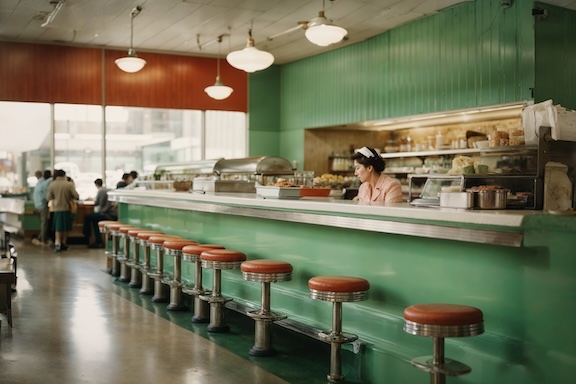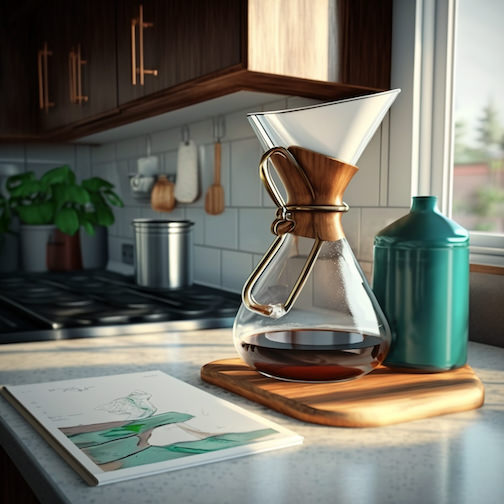As a fan of the Mid-Century times in evoking the nostalgic charm of bygone eras, there’s a unique joy in curating a kitchen space for the coffee lover with a penchant for mid-century aesthetics. The era, stretching from the mid-1940s to the late 1960s, was a renaissance of interior design, where functionality and form danced together in an elegant ballet. For coffee lovers like me, this period offers a treasure trove of designs that are not just about brewing a morning cup but about celebrating the ritual of coffee making. In setting up a kitchen that breathes mid-century modernity, each coffee maker is selected not merely as an appliance but as a centerpiece that tells a story.
These pieces, from the sculptural grace of percolators to the understated elegance of the Chemex, are more than mere relics; they are functional artworks. They encapsulate the essence of mid-century design – minimal yet expressive, practical yet enchanting. The journey through selecting these mid-century coffee makers isn’t just about recapturing a style; it’s about rekindling a love affair with the art of coffee in an era that reimagined the modern kitchen.
Let’s go over what to look for with Mid Century style in mind, then where it may be possible to find those items. Each of the coffee maker styles have a unique look, brewing process and flavor. Decide if you are looking for a particular flavor or aesthetic.
Percolators: These were perhaps the most iconic coffee makers of the mid-century. Made of chrome, stainless steel, or even colorful enameled metal, percolators often featured a sleek, almost sculptural design. They worked by cycling boiling water through coffee grounds using gravity until the desired strength was reached.
Chemex Coffee Maker: Invented in 1941, the Chemex has a timeless design and is still popular today. It’s known for its hourglass shape and uses a pour-over method of brewing. Made of glass and often accompanied by a wooden collar, it epitomizes the mid-century modern aesthetic.
Siphon (or Vacuum) Coffee Makers: These were more elaborate and theatrical in their brewing method. Consisting of two stacked chambers with a siphon tube, they used vapor pressure and vacuum to brew coffee. They often featured glass and chrome materials, fitting well with the mid-century modern style.
Electric Drip Coffee Makers: Introduced in the later part of the mid-century period, these were more about convenience. They had a more utilitarian design compared to percolators but started to introduce the automatic brewing process we’re familiar with today.
Moka Pots: Although more associated with European homes, Moka pots were also found in mid-century American kitchens. Made of aluminum or stainless steel, they have a distinctive octagonal shape and brew coffee using steam pressure.
Now, a few options to find what you’re looking for –
Antique Stores and Flea Markets: These are excellent places to find original mid-century coffee makers. Items here can range from well-preserved pieces to ones that need a bit of restoration. It’s also a great way to get a feel for the era’s design firsthand. Most locations are a variety of resellers, some may not know how popular an item is so they will price lower, strictly based on a markup from what they purchased the item for. It doesn’t hurt to ask the person at the front if they know of any resellers with the items you’re looking for.
Online Marketplaces: Websites like eBay, Etsy, and Craigslist often have listings for vintage coffee makers. You can find a wide range of options, from percolators to Chemex coffee makers. Be sure to check the condition and authenticity, and ask sellers for more information if needed. Never do an in person cash purchase in a private area or by yourself.
Specialty Vintage Shops: Some shops specialize in mid-century modern furniture and appliances. These are more curated than general antique stores and might offer higher-quality finds. With that exceptional quality comes higher prices too.
Estate Sales and Auctions: These can be goldmines for vintage items. Estate sales often happen when someone is downsizing or after a family member has passed away, and they can include a range of household items from the mid-century period. Finding these can be done through specialized sites, most not requiring a person to be a member or carry any sort of certification to go. Rain or shine, if the sale has good things listed, there will be a line as they limit the number of people in. Many people do not enjoy the experience of going through a recently passed individual’s house. Most have a professional service go through and to organize and price, these folks will generally pull things of high value out for them to sell via other channels, lucky for you and me, mid century kitchen doesn’t usually fit that area for them.
Online Retailers and Reproductions: If you prefer new items with a vintage look, many retailers sell reproductions of mid-century designs. These can offer the aesthetic of the era with the convenience and reliability of modern manufacturing. I see these all the time on Instagram as inline sponsored ads. As mentioned below, some of those can look similar but be modernized to better fit your lifestyle.
Facebook Groups: Joining groups or forums dedicated to mid-century modern design can be helpful. Members often share tips on where to find items, and you might come across local sellers. They are always a source for great pics of other people’s collection, as well tips for caring and using your finds.
Thrift Stores: While it can be hit or miss, thrift stores sometimes have mid-century items at lower prices. Regular visits are necessary to find what you’re looking for as there is usually a group that hangs out and grabs things they can resell. Sometimes, a less known item will go undetected for you to grab.
Remember to Verify Authenticity, not everyone that sells knows the history. Take your time to Check Condition, especially if friends and family will be admiring or your going to be using it. Compare Prices with both other resources as well other models that may look the same but may have different features, like drip coffee makers. Finally, Consider Your Need, it is the process of the way things were done before or you want the look but need the modern speed due to your life.
Please note that if you purchase from clicking on the link, some will result in my getting a tiny bit of that sale to help keep this site going. If you enjoy my work, perhaps you would consider donating to my daily cup of coffee, thank you.



